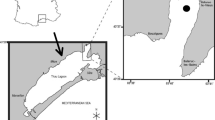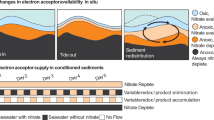Abstract
The chemoautotrophic fixation of carbon dioxide is responsible for an appreciable component of the organic matter apparent as a carbon-rick peak at 40 cm sub-bottom in the marine muds of Halifax Harbour, Nova Scotia, Canada. Dissolved oxygen and sulfide profiles show that the 40 cm horizon represents a transitional environment from aerobic to underlying anaerobic conditions. A dissolved sulfate maximum and pH minimum at 40 cm indicate that sulfur-oxidizing chemoautotrophs are associated with the organic carbon production at this horizon. The stimulation of CO2-fixation by thiosulfate and inhibition by anaerobic conditions, ammonia, nitrate and nitrite further support the contention that sulfur-oxidizers are primary producers at this horizon. Heterotrophic activity data show that both aerobic and anaerobic heterotrophs are active in the sediments. These data, in conjunction with the measurement of CO2-fixation and the calculation of organic carbon accumulation over time, show that the peak of organic carbon observed is residual carbon that is not heterotrophically recycled to CO2 at the 40 cm horizon.
Similar content being viewed by others
Literature Cited
Bowden, W.B.: Comparison of two direct-count techniques for enumerating aquatic bacteria. Appl. envirl Microbiol. 33, 1229–1232 (1977)
Cline, J.D.: Spectrophotometric determination of hydrogen sulfide in natural waters. Limnol. Oceanogr. 14, 454–458 (1969)
Goldberg, E.D., Y. Hodge, M. Koide, J. Griffen, E. Gamble, O.P. Bricker, G. Matisoff, G.R. Holdren, Jr. and R. Braun: A pollution history of Chesapeake Bay. Geochim. cosmochim. Acta 42, 1413–1425 (1978)
Goldhaber, M.B., R.C. Aller, J.K. Cochran, J.K. Rosenfeld, C.S. Martens and R.A. Berner: Sulfate reduction, diffusion and bioturbation in Long Island Sound sediments: Report of the FOAM group. Am. J. Sci. 277, 193–237 (1977)
Griffiths, R.P., S.S. Hayasaka, T.M. McNamara and R.Y. Morita: Comparison between two methods of assaying relative microbial activity in marine environments. Appl. envirl Microbiol. 34, 801–805 (1977)
Howarth, R.W.: A rapid and precise method for determining sulfate in seawater, estuarine waters and sediment pore waters. Limnol. Oceanogr. 23, 1066–1069 (1978)
Kepkay, P.E., R.C. Cooke and J.A. Novitsky: Microbial autotrophy: a primary source of organic carbon in marine sediments. Science, N.Y. 204, 68–69 (1979)
Kuenen, J.G.: Colourless sulfur bacteria and their role in the sulfur cycle. Pl. Soil 43, 49–76 (1975)
Rau, G.H. and J.I. Hedges: Carbon-13 depletion in a hydrothermal vent mussel: suggestion of a chemosynthetic food source. Science, N.Y. 203, 648–649 (1979)
Sorokin, Yu.I.: The bacterial population and the process of hydrogen sulfide oxidation in the Black Sea. J. Cons. int. Explor. Mer 34, 423–454 (1972)
stanier, R.Y., E.A. Adelberg and J. Ingraham: The microbial world, 871 pp. Englewood Cliffs, New Jersey: Prentice Hall 1976
Strickland, J.D.H. and T.R. Parsons: A practical handbook of seawater analysis, rev. ed. Bull. Fish. Res. Bd Can. 167, 1–310 (1972)
Tuttle, J.H. and H.W. Jannasch: Occurrence and types of Thiobacillus-like bacteria in the sea. Limnol. Oceanogr. 17, 532–543 (1972)
——: Sultide and thiosulfate-oxidizing bacteria in anoxic marine basins. Mar. Biol. 20, 64–70 (1973)
Vitolins, M.I. and R.J. Swaby: Activity of sulfur-oxidizing microorganisms in some Australian soils. Aust. J. Soil Res. 7, 171–183 (1969)
Wright, R.T. and J.E. Hobbie: Use of glucose and acetate by bacteria and algae in aquatic ecosystems. Ecology 47, 457–464 (1966)
Author information
Authors and Affiliations
Additional information
Communicated by T. Platt, Dartmouth
Rights and permissions
About this article
Cite this article
Kepkay, P.E., Novitsky, J.A. Microbial control of organic carbon in marine sediments: Coupled chemoautotrophy and heterotrophy. Mar. Biol. 55, 261–266 (1980). https://doi.org/10.1007/BF00393778
Accepted:
Issue Date:
DOI: https://doi.org/10.1007/BF00393778




